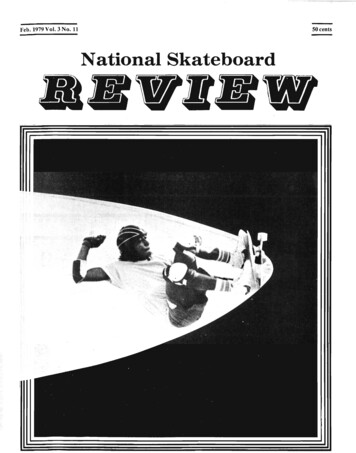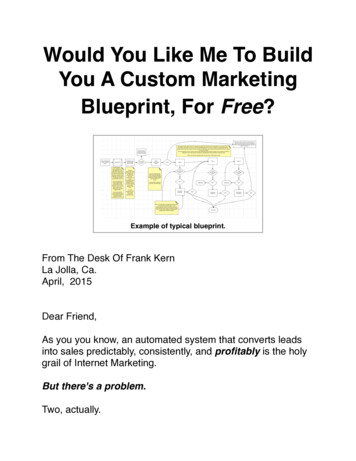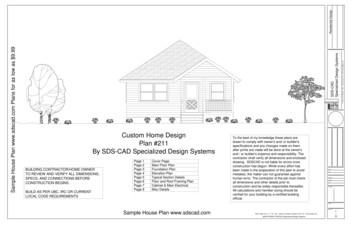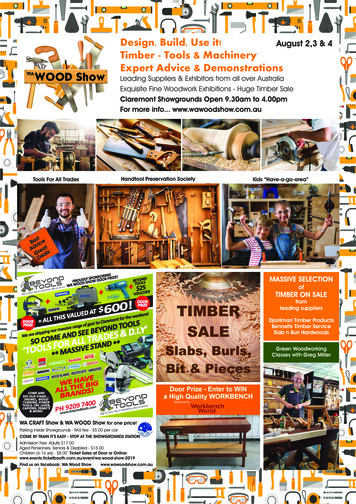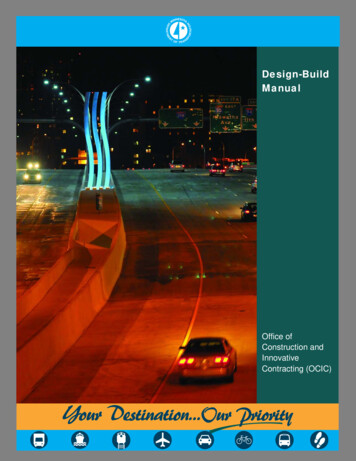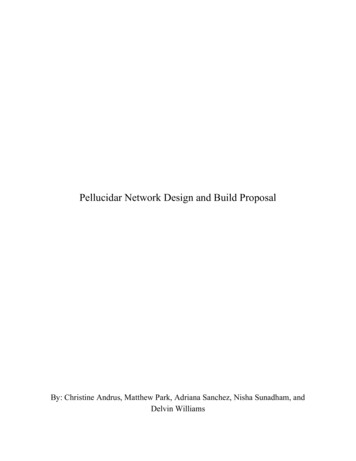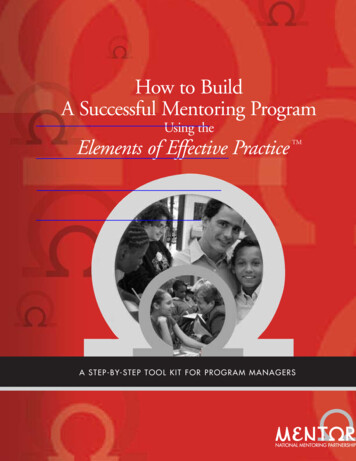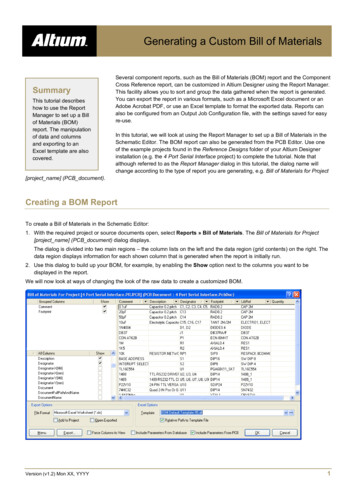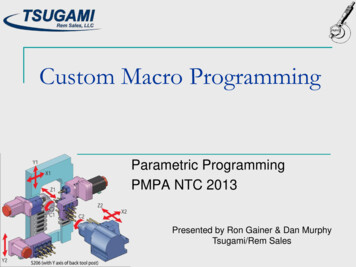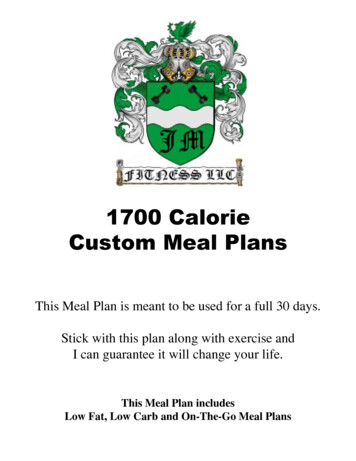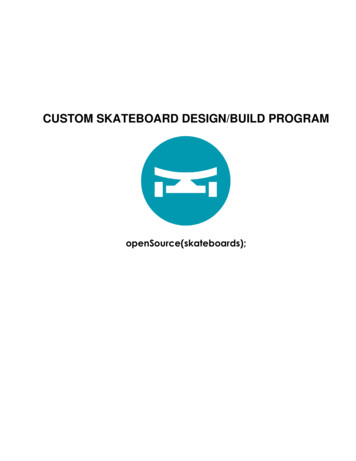
Transcription
CUSTOM SKATEBOARD DESIGN/BUILD PROGRAMopenSource(skateboards);
ContentsApplicable Standards . 3Syllabus . 5Lesson 1:User-Focused Design . 7Lesson 2:Measurements & Design . 15Lesson 3:CAD (Computer Aided Design) . 20Lesson 4:Mold-Making & Applied Mathematics . 27Lesson 5:Vacuum Forming . 32Lesson 6:Woodworking . 38Lesson 7:Art and Reflections . 42APPENDIX . 44Lesson 1: lesson1-slides.pptx . 45Lesson 2: Skateboard Design Guide . 51Lesson 2: Skateboard Dimension Template . 56Lesson 3: DraftSight Cheat Sheet . 58Lesson 4: Mold Making Checklist . 59Lesson 4: Side Concave – Teacher’s Guide . 69Lesson 5: Glue-Up Supplies Checklist . 72Lesson 5: How Much Force? . 73Lesson 6: Finishing Guide . 74
Applicable StandardsApplicable StandardsSee specific lesson plans for implementation details.NGSS:MS-ETS1-1 Engineering Design: Define the criteria and constraints of a design problem withsufficient precision to ensure a successful solution, taking into account relevant scientificprinciples and potential impacts on people and the natural environment that may limit possiblesolutions.Common Core:CCSS.Math.Content.5.G.A.1: Use a pair of perpendicular number lines, called axes, to define a coordinatesystem, with the intersection of the lines (the origin) arranged to coincide with the 0 on each line and agiven point in the plane located by using an ordered pair of numbers, called its coordinates. Understandthat the first number indicates how far to travel from the origin in the direction of one axis, and thesecond number indicates how far to travel in the direction of the second axis, with the convention that thenames of the two axes and the coordinates correspond (e.g., x-axis and x-coordinate, y-axis and ycoordinate).CCSS.Math.Content.6.NS.C.5: Understand that positive and negative numbers are used together todescribe quantities having opposite directions or values (e.g., temperature above/below zero, elevationabove/below sea level, credits/debits, positive/negative electric charge); use positive and negativenumbers to represent quantities in real-world contexts, explaining the meaning of 0 in each situation.CCSS.Math.Content.6.NS.C.8: Solve real-world and mathematical problems by graphing points in all fourquadrants of the coordinate plane. Include use of coordinates and absolute value to find distancesbetween points with the same first coordinate or the same second coordinate.CCSS.Math.Content.7.NS.A.1: Apply and extend previous understandings of addition and subtraction toadd and subtract rational numbers; represent addition and subtraction on a horizontal or vertical numberline diagram.CCSS.Math.Content.7.G.A.2 : Draw (freehand, with ruler and protractor, and with technology) geometricshapes with given conditions. Focus on constructing triangles from three measures of angles or sides,noticing when the conditions determine a unique triangle, more than one triangle, or no triangle.CCSS.Math.Content.7.G.A.3: Describe the two-dimensional figures that result from slicing threedimensional figures, as in plane sections of right rectangular prisms and right rectangular pyramids.CCSS.Math.Content.8.G.A.1: Verify experimentally the properties of rotations, reflections, andtranslations.CCSS.Math.Content.8.G.B.7: Apply the Pythagorean Theorem to determine unknown side lengths in righttriangles in real-world and mathematical problems in two and three dimensions.3
Applicable StandardsCCSS.Math.Content.HSA.CED.A.1: Create equations and inequalities in one variable and use them to solveproblems. Include equations arising from linear and quadratic functions, and simple rational andexponential functions.CCSS.Math.Content.HSA.CED.A.4: Rearrange formulas to highlight a quantity of interest, using the samereasoning as in solving equations. For example, rearrange Ohm’s law V IR to highlight resistance R.CCSS.Math.Content.HSA.REI.B.4: Solve quadratic equations in one variable.CCSS.Math.Content.HSG.GMD.B.4: Identify the shapes of two-dimensional cross-sections of threedimensional objects, and identify three-dimensional objects generated by rotations of 1: Use geometric shapes, their measures, and their properties to describeobjects (e.g., modeling a tree trunk or a human torso as a cylinder.CCSS.Math.Content.HSG.SRT.C.8: Use trigonometric ratios and the Pythagorean Theorem to solve righttriangles in applied problems.CCSS.Math.Content.HSG.MG.A.3 Apply geometric methods to solve design problems (e.g., designing anobject or structure to satisfy physical constraints or minimize cost; working with typographic grid systemsbased on ratios).CCSS.ELA-Literacy.RI.6.3: Analyze in detail how a key individual, event, or idea is introduced, illustrated,and elaborated in a text (e.g., through examples or anecdotes).CCSS.ELA-Literacy.RI.6.7: Integrate information presented in different media or formats (e.g., visually,quantitatively) as well as in words to develop a coherent understanding of a topic or issue.CCSS.ELA-Literacy.RST.6-8.3: Follow precisely a multistep procedure when carrying out experiments,taking measurements, or performing technical tasks.CCSS.ELA-Literacy.RST.9-10.3: Follow precisely a complex multistep procedure when carrying outexperiments, taking measurements, or performing technical tasks, attending to special cases or exceptionsdefined in the text.4
SyllabusSyllabusDescription:In this program, students use engineering, technology, and math to design and build their own custom skateboarddecks! Students sketch their ideas and convert them into digital drawings using CAD. They hand-shape a foammold, and use the mold to vacuum-form 7 sheets of maple veneers into a skateboard shape. Students createtemplates from their CAD models and shape their boards, while learning the safety and basic operation of powertools. After final sanding, the students will seal their skateboard decks and apply art to give their product one lastcustom touch.Structure:This program is broken into four modules, each of which containing more focused lessons:1)2)3)4)Design and CADMold MakingVacuum FormingFinishingTime estimate: basic: 250 minutes; advanced: 450 minutesTime estimate: basic: 130 minutes; advanced: 150 minutesTime estimate: 150 minutesTime estimate: basic: 250 minutes; advanced: 350 minutesLessonsTime estimateLesson 1:User-Focused DesignLesson 2:Measurements & Sketching (50 min)Lesson 3:CAD ModelingLesson 4:Mold Making & Applied Math (130-150 min)Lesson 5:Vacuum Forming(150* min)Lesson 6:Woodworking(150* min)Lesson 7:Art & Reflections(100-200 min)Modules(50 min)Design & CAD(150-350 min)Mold MakingVacuum FormingFinishing*Varies with class sizeCopyright 2016-present Open Source Skateboards. This document or any portion thereof may not be reproducedor used in any manner whatsoever without the express written permission of Open Source Skateboards.5
SyllabusBefore you begin: There are a number optional of “advanced” activities, which may be included for more mature students. Some students may finish certain activities before other students. Those students may be allowed to helptheir classmates finish, or they can brainstorm and sketch concepts for their board graphic. Also, theinstructor may encourage these students to pursue the “advanced” activities independently or otheractivities as defined by the instructor. Additional handouts, instructor guides, and documentation are provided as attachments to this syllabus. A “Comprehension Demonstration” section is included at the end of each lesson plan with relevantquestions for students, and may be incorporated as a review or at appropriate times during the lesson. Online video links and tutorials are provided when available.Vimeo Video Password*:DesignBuildSk8*This password is required for accessing ad-free video content.For questions or additional .opensourceboards.com/contact/Have Fun!Copyright 2016-present Open Source Skateboards. This document or any portion thereof may not be reproducedor used in any manner whatsoever without the express written permission of Open Source Skateboards.6
Lesson 1Lesson 1: User-Focused DesignStandardsNGSS:MS-ETS1-1 Engineering Design: Define the criteria and constraints of a designproblem with sufficient precision to ensure a successful solution, taking intoaccount relevant scientific principles and potential impacts on people and thenatural environment that may limit possible solutions.Time Estimate:50 minutesLearning objectives:1)2)3)4)Students will make observations about skateboard shapes and their different uses.Students will understand how geometry affects the skateboarding experience.Students will learn about the different components that make up a complete skateboard and their names.Students will learn how to design with constraints.Lesson outcome:1) Each student will draw simple sketches of their different skateboard shape ideas within the providedconstraints.Materials: Projector or large monitor/screenInternet accessPaperPencilsSkateboard (optional)Reference materials: lesson1-slides.pptx (PowerPoint slides)http://bit.ly/SK8CADlite (SK8CADlite - skateboard design CAD software – no download required)Class breakdownClass intros & overview:Icebreaker: What’s your name and what do you like to make?Appx. time:5 minutesProcess overview (review the process with the class):Copyright 2016-present Open Source Skateboards. This document or any portion thereof may not be reproducedor used in any manner whatsoever without the express written permission of Open Source Skateboards.7
Lesson 1What will we do?Sketch and design your own custom skateboard deckMake your own foam mold by handUse vacuum-forming to press your skateboard deckUse power tools to shape your boardSand and drill your boardPut custom artwork on your boardLearn: Anatomy of a Skateboard:Appx. time:5 minutesDeck: the platform the skateboarder stands on.Grip tape: an abrasive, sandpaper-like surface with adhesive on one side for sticking onto your deck. The abrasiveside provides grip to prevent the skateboarder’s feet from slipping.Trucks: provide axles for mounting the wheels and allow the skateboarder to turn when leaning left or right.There are two trucks per skateboard.Risers/riser pads: go between the trucks and the deck. They “raise” the deck away from the wheels so that thedeck does not touch the wheels on sharp turns. They also provide a cushion for the contact between the hardmetal and wood surfaces, which helps to prevent stress cracks in the deck (these may also be called “shock pads”).There are two risers per skateboard.Wheels: typically made of urethane and allow the skateboarder to roll. There are four wheels per skateboard.Copyright 2016-present Open Source Skateboards. This document or any portion thereof may not be reproducedor used in any manner whatsoever without the express written permission of Open Source Skateboards.8
Lesson 1Bearings: allow the wheels to spin smoothly. There are eight bearings per skateboard (two per wheel).Bolts: attach the trucks to the deck when paired with nuts. There are eight bolts per skateboard.Nuts: fasten the trucks to the deck and fasten the wheels to the trucks. There are twelve nuts per skateboard(eight attach to the bolts and four attach to the trucks).Exercise: “Understanding the User”:Each student must create a table on paper similar to the following:Video NumberAppx. time:15 minutesObservationsThe instructor will play the following four videos for the class. Each video highlights a different style ofskateboarding. For each video, the students write down their observations about the ways the skateboarders areus
In this program, students use engineering, technology, and math to design and build their own custom skateboard decks! Students sketch their ideas and convert them into digital drawings using CAD. They hand-shape a foam mold, and use the mold to vacuum-form 7 sheets of maple veneers into a skateboard shape. Students create
